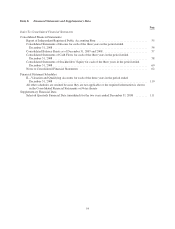Yahoo 2008 Annual Report Download - page 54
Download and view the complete annual report
Please find page 54 of the 2008 Yahoo annual report below. You can navigate through the pages in the report by either clicking on the pages listed below, or by using the keyword search tool below to find specific information within the annual report.Intellectual Property Rights. We are committed to make certain payments under various intellectual property
arrangements of up to $52 million through 2023.
Other Commitments. In the ordinary course of business, we may provide indemnifications of varying scope and terms
to customers, vendors, lessors, joint venture and business partners, purchasers of assets or subsidiaries and other parties
with respect to certain matters, including, but not limited to, losses arising out of our breach of agreements or
representations and warranties made by us, services to be provided by us, intellectual property infringement claims
made by third parties or, with respect to the sale of assets or a subsidiary, matters related to our conduct of the business
and tax matters prior to the sale. In addition, we have entered into indemnification agreements with our directors and
certain of our officers that will require us, among other things, to indemnify them against certain liabilities that may
arise by reason of their status or service as directors or officers. We have also agreed to indemnify certain former
officers, directors, and employees of acquired companies in connection with the acquisition of such companies. We
maintain director and officer insurance, which may cover certain liabilities arising from our obligation to indemnify
our directors and officers and former directors and officers of acquired companies, in certain circumstances. It is not
possible to determine the aggregate maximum potential loss under these indemnification agreements due to the limited
history of prior indemnification claims and the unique facts and circumstances involved in each particular agreement.
Such indemnification agreements may not be subject to maximum loss clauses. Historically, we have not incurred
material costs as a result of obligations under these agreements and we have not accrued any liabilities related to such
indemnification obligations in our consolidated financial statements.
As of December 31, 2008, we did not have any relationships with unconsolidated entities or financial
partnerships, such as entities often referred to as structured finance or special purpose entities, which would have
been established for the purpose of facilitating off-balance sheet arrangements or other contractually narrow or
limited purposes. As such, we are not exposed to any financing, liquidity, market, or credit risk that could arise if
we had engaged in such relationships.
Critical Accounting Policies and Estimates
Our discussion and analysis of our financial condition and results of operations is based upon our consolidated
financial statements, which have been prepared in accordance with U.S. GAAP. The preparation of these
consolidated financial statements requires us to make estimates, judgments, and assumptions that affect the
reported amounts of assets, liabilities, revenues and expenses, and the related disclosure of contingent assets and
liabilities. We base our estimates on historical experience and on various other assumptions that we believe are
reasonable under the circumstances, the results of which form the basis for making judgments about the carrying
values of assets and liabilities that are not readily apparent from other sources. Actual results may differ from
these estimates.
An accounting policy is considered to be critical if it requires an accounting estimate to be made based on
assumptions about matters that are highly uncertain at the time the estimate is made, and if different estimates
that reasonably could have been used, or changes in the accounting estimate that are reasonably likely to occur,
could materially impact the consolidated financial statements. We believe that the following critical accounting
policies reflect the more significant estimates and assumptions used in the preparation of the consolidated
financial statements.
Management has discussed the development and selection of these critical accounting estimates with the Audit
Committee of our Board and the Audit Committee has reviewed the disclosure below. In addition, there are other
items within our financial statements that require estimation, but are not deemed critical as defined above.
Changes in estimates used in these and other items could have a material impact on our financial statements.
Revenue Recognition. Our revenues are generated from marketing services and fees. Marketing services revenues
are generated from several offerings including: the display of textual, graphical advertisements, display of text-
based links to advertisers’ Websites, listing based services, and commerce-based transactions. Fees revenues
48
























